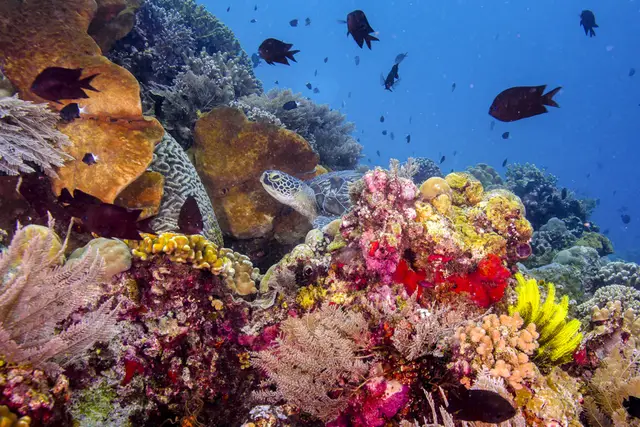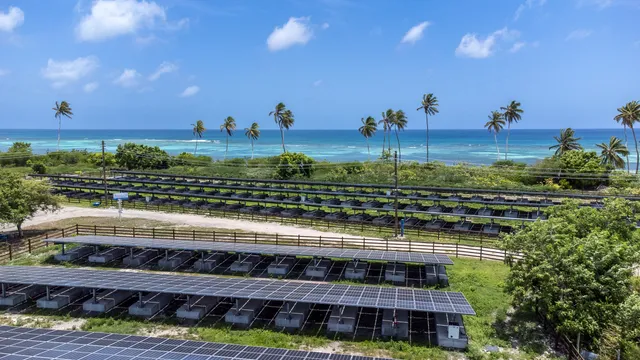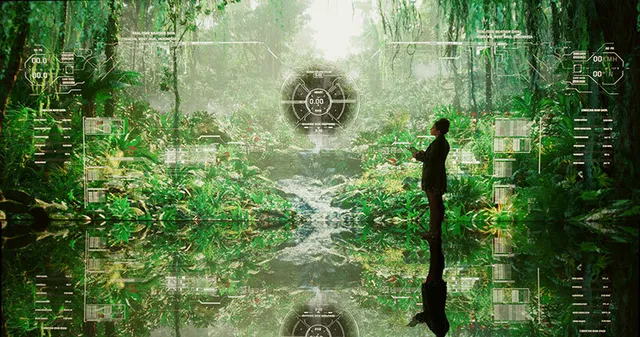Environmental science is a big umbrella term, ranging from field studies and data analysis to laboratory experiments and modeling. Professionals in this field work to understand and mitigate environmental issues, contributing to the well-being of humanity and the planet. For instance, environmental scientists analyze air and water quality to inform pollution control measures. Conservation biologists work to protect endangered species and ecosystems, ensuring biodiversity. Eco-architects design structures that minimize their environmental impact, conserve resources, and promote energy efficiency. Environmental engineers design solutions for sustainable energy and waste management. This work takes place in diverse settings, from government agencies and research institutions to nonprofit organizations and consulting firms. Less known examples include environmental anthropologists studying the cultural aspects of environmental issues or environmental economists analyzing the economic impacts of conservation efforts.
Here are some types of environmental science research that’s currently being done:
Climate Change Modeling helps researchers study climate patterns, greenhouse gas emissions, and temperature trends and predict the impacts of climate change on ecosystems, weather patterns, and human societies.
Biodiversity Conservation focuses on understanding, monitoring, and conserving the variety of life on Earth. Scientists investigate the factors influencing biodiversity loss and work on strategies to protect endangered species and ecosystems.
Pollution Assessment and Remediation gives us a way to assess the extent of pollution in a community’s air, water, and soil supply and to develop methods of healing contaminated environments and preventing further pollution.
Sustainable Agriculture establishes farming methods that minimize environmental impact, enhance soil health, and promote sustainable food production. This includes studying crop rotation, agroforestry, and organic farming practices.
Renewable Energy Studies contribute to the development of sustainable energy sources, such as solar, wind, and hydropower. Researchers investigate the environmental impacts and feasibility of implementing renewable energy technologies.
Urban Ecology explores the interactions between ecosystems and urban environments in order to help design cities that are more sustainable, resilient, and conducive to biodiversity.
Waste Management and Recycling tries to minimize the environmental impact of waste by studying effective recycling methods, waste reduction strategies, and environmentally friendly disposal practices.
Environmental Policy and Governance influence environmental policies, evaluate their impact on ecosystems and communities, and propose recommendations for more sustainable governance practices.
Whether in the lab, out in nature, or behind a computer, environmental science careers offer you the chance to address pressing environmental challenges and literally save the world.
One of the most immediate ways to get into this field is by paying close attention to the environmental challenges in your own community. Are there issues with air quality, a lack of recycling options, contaminated water, noise pollution, urban sprawl? Consider volunteering for environmental initiatives in your community; hands-on experience is invaluable. Reach out to local environmental organizations or professionals for mentorship opportunities or informational interviews. They can share insights into the field and offer advice on potential career paths. Attend workshops, conferences, or guest lectures to stay informed about current trends and network with like-minded individuals. Lastly, don't forget the power of nature itself—spend time outdoors biking, kayaking, or simply walking around, observing the wildlife, and appreciating the environment. As Rachel Carson wrote in her book Silent Spring, “The more clearly we can focus our attention on the wonders and realities of the universe about us, the less taste we shall have for destruction.”
Here are some specific classes, books, and extracurriculars that can help you form a good foundation for an environmental science career.
1. Take a Class in High School
Here are some standard and not-so-obvious courses that can help prepare you for a career in environmental science:
Biology and Chemistry - No matter the type of environmental science you want to get into, these are the essentials. When given the option, consider taking the Advanced Placement (AP) or Honors version of these courses since they can offer more in-depth content and better prepare you for college-level coursework.
Geography provides a spatial perspective crucial for understanding environmental patterns and processes. It helps you grasp how landscapes, ecosystems, and human activities are interconnected.
Economics will enable you to assess the cost-benefit analyses of conservation projects, sustainable practices, and environmental policies.Environmental issues often involve financial considerations.
Statistics is a powerful tool for analyzing environmental data. From studying climate trends to assessing biodiversity, statistical skills are crucial for making informed decisions and drawing meaningful conclusions from research.
Philosophy provides a foundation for ethical decision-making in environmental science. It helps you navigate the complex moral issues surrounding environmental challenges and solutions.
Civics helps provide insight into regulations, policies, and the role of government in environmental issues. Understanding the legal frameworks governing environmental protection is essential.
Computer Science or Geographic Information Systems (GIS) help you manipulate and analyze large datasets, model environmental systems, and create maps for research and presentations.
Writing courses enhance your ability to convey scientific findings to diverse audiences, whether through reports, articles, or public outreach.
Foreign Languages (especially Spanish or another widely spoken language) can open up opportunities for international collaboration and research, especially if you're interested in studying ecosystems or conservation efforts in different regions. Environmental issues are global after all.
If your school doesn’t offer one of these courses or you want to progress to more advanced levels, you could pursue a virtual version on Coursera, edX, MIT OpenCourseWare, or Khan Academy.
2. Read a Book
Classics like Silent Spring and A Sand County Almanac can help lay the groundwork for foundational environmental concepts. For more recent insights, dive into The Sixth Extinction and Braiding Sweetgrass. While some may find the scientific language challenging, don't be discouraged—approach them with curiosity and take it chapter by chapter. Supplement your reading with podcasts and documentaries to enhance your understanding. These books offer not only knowledge but also a deeper connection to the urgent environmental issues shaping our world. Enjoy the adventure of discovery!
Silent Spring by Rachel Carson (1962) - A classic that sparked the modern environmental movement, Carson's work explores the dangers of pesticides and their impact on ecosystems, making it a foundational text in environmental science.
A Sand County Almanac by Aldo Leopold (1949) - Leopold's eloquent reflections on nature and conservation have become fundamental to the understanding of ecological ethics and the interconnectedness of all living things.
The Sixth Extinction by Elizabeth Kolbert (2014) - This Pulitzer Prize-winning book examines the ongoing mass extinction of species caused by human activities, offering a comprehensive look at the current state of biodiversity.
Braiding Sweetgrass by Robin Wall Kimmerer (2013) - Blending indigenous wisdom with scientific insights, Kimmerer explores our relationship with nature and the importance of reciprocity in environmental stewardship.
This Changes Everything by Naomi Klein (2014) - Klein delves into the relationship between climate change and economic systems, challenging conventional wisdom and urging a reevaluation of how we approach environmental issues.
The Uninhabitable Earth: Life After Warming by David Wallace-Wells (2019) - Wallace-Wells explores the potential impacts of climate change on our planet, painting a vivid picture of the challenges we face and the urgent need for action.
The Future We Choose: Surviving the Climate Crisis by Christiana Figueres and Tom Rivett-Carnac (2020) - Figueres and Rivett-Carnac, key figures in the Paris Agreement negotiations, outline possible pathways for addressing the climate crisis and creating a sustainable future.
To help you stay updated on the latest issues, you can follow reputable journals and news outlets, such as Nature, Environmental Science & Technology, Ecology, National Geographic, and The Guardian. Podcasts such as Living on Earth or The Infinite Monkey Cage discuss current environmental topics and interview experts. Organizations such as Sierra Club, Greenpeace, and World Wildlife Fund also provide newsletters, webinars, and resources to keep their members informed.
3. Extracurricular Study
To get more hands-on experience and strengthen teamwork and problem-solving skills, you can seek out environmental science related activities such as these.
Community Garden or Urban Farming - Participating in a community garden or urban farming project exposes you to hands-on experience with plant biology, soil science, and sustainable agriculture. It develops practical skills in horticulture, water conservation, and ecosystem management, fostering a deep understanding of environmental systems.
Environmental Journalism or Blogging - Researching and reporting on local or global environmental issues enhances your ability to articulate complex concepts to a broader audience, a valuable skill for environmental science advocacy and education.
Citizen Science Initiatives - Joining citizen science projects, such as bird watching or water quality monitoring, enables you to actively contribute to scientific research while gaining practical field experience. It fosters data collection and analysis skills, vital for environmental scientists, and promotes a sense of community involvement.
Photography Club - Exploring environmental themes through photography (or any other artwork) fosters creativity and a unique perspective on ecological issues. It develops your ability to communicate environmental messages visually, a skill increasingly important in raising awareness and promoting conservation efforts.
Waste Reduction and Recycling Campaign - Leading or participating in a waste reduction and recycling campaign provides practical insights into waste management. It develops organizational and leadership skills, while understanding the environmental impact of waste contributes to your overall knowledge of sustainability.
River or Coastal Cleanup Crew - Participating in cleanup efforts along rivers or coastlines exposes you to the direct impact of pollution on ecosystems. It enhances observational and problem-solving skills while fostering a sense of responsibility for environmental stewardship.
Green Building or Renewable Energy Projects - Involvement in green building or renewable energy initiatives introduces you to sustainable technologies and design. It provides insights into energy efficiency, resource conservation, and sustainable infrastructure, contributing to a well-rounded understanding of environmental science.
Mock Trial Team - Joining a debate or mock trial team focused on environmental issues sharpens your critical thinking and argumentation skills. It allows you to explore environmental policy and law, providing a unique perspective on the legal aspects of environmental science.
Volunteering opportunities for environmental science are pretty high! This is because every modern community in this Anthropocene era is grappling with the significant and lasting impact of our human activities on the natural environment. You can start right away by reaching out to local environmental organizations, universities, or professionals in your community. Don't hesitate to talk to your science teachers for guidance. Remember, every small action can have a cumulative impact. Here are more specifics on finding an environmental science research project and mentors you can work with.
Find research programs close to home
To find environmental science research opportunities close to home, check out our High School Student Research Opportunities Database. Click on your state, then search based on your location, institution, event type (in-person or virtual), and tuition (paid or free).
Also read 12 Environmental Science Research Opportunities for High School Students.
Work with a professor
If you have a clear project idea, you can reach out to professors in your field to see if they are open to collaborating with you. Refer to our Guide to Cold-Emailing Professors (written by Polygence literature research mentor Daniel Hazard, a Ph.D. candidate at Princeton University).
Engage in your own research project
You can absolutely undertake an independent environmental science research project. Start by identifying your interest, formulating a focused research question, and conducting a thorough literature review. Carly Taylor, a Stanford University senior who has completed several research projects this way, outlined a guide about how to write a self-guided research paper. By reading it, you’ll get a better understanding of what to expect when taking on this type of project. If you would like a little guidance and support, you can also choose to work with one of our Polygence environmental science mentors.
Enter a competition
The requirements and deadlines that competitions require you to meet provide a very helpful structure to keep your research moving forward. For some competition options, check out our post Top 10 Science Fairs and Competitions for High School Students in 2023. Another benefit to attending a competition is that you will meet other inspiring students, teachers, and even experts in the field you love most.
Here are some top picks for summer environmental science research programs.
1. Climate Change Mitigation
Hosting institution: CIEE
Cost: $5,250 USD
Format: In person (Monteverde, Costa Rica)
Application deadline: Late January
Costa Rica is widely seen as one of the most biodiverse regions on the planet. Students spend three weeks here exploring this tropical ecosystem of the Monteverde Cloud Forest Reserve. Participants meet with local farmers, scientists, and activists, quantify tropical tree growth, estimate carbon stocks, and measure the environmental effects of greenhouse gasses all with the possible outcome of starting carbon-smart initiatives in local communities worldwide.
2. Global Environmental Leadership & Sustainability
Hosting institution: UC San Diego
Cost: $3,600 plus $100 application fee
Format: In person (Hawa’ii, HI)
Application deadline: Early March
For 10 days students explore scientific research alongside leadership skills through various activities from a value-based process, emphasizing the Social Change Model of Leadership. Participants learn to become competent stewards. The course end goal is for each participant to develop a personal action plan to incorporate the 7 C’s of the Social Change Model of Leadership into their daily lives back home.
3. SEA Summer High School Programs
Hosting institution: Sea Education Association
Cost: $1,000 - $5,950 USD (program costs vary)
Format: Virtual and In-person (Woods Hole, MA) options available
Application deadline: Mid April
Over the course of two weeks, students may opt for “Ocean Studies on the Cape,” “Critters, Coral, and Conservation,” or other areas of study. Coursework might include lectures, discussions, laboratory activities, and field trips to reveal the study of oceanography, the history of humanity’s relationship with the oceans, and modern maritime issues. Leadership training, field work, and community life on campus round out the experience, inspiring students to view the world in a new way.
1. Student Conservation Association (SCA) Internship
Hosting institution: Student Conservation Association (SCA)
Compensation: Varies; some positions offer stipends or AmeriCorps education awards.
Location: Various locations across the United States
Application deadline: Varies by position; typically, applications open several months before the start date.
The SCA Internship provides high school students with immersive opportunities to engage in conservation projects across the United States. While compensation varies, many positions offer stipends or AmeriCorps education awards. The format is hands-on and in-person, allowing participants to work on impactful environmental projects. The application deadline varies by position, and interested students can explore the SCA website for current opportunities. The internship not only provides practical experience in environmental conservation but also fosters a sense of environmental stewardship through active engagement in diverse ecosystems.
2. Environmentor Internship
Hosting institution: Rockaway Initiative for Sustainability and Equity (RISE)
Compensation: Varies; some positions may offer stipends or educational benefits.
Location: Rockaway Peninsula, NY
Application deadline: Check the RISE website for the most current application information.
The Environmentor Internship at RISE offers high school students an opportunity to actively contribute to environmental sustainability in the Rockaway Peninsula, New York. While compensation varies, some positions may provide stipends or educational benefits. This hands-on, in-person internship allows students to engage in projects addressing local environmental challenges. The application deadline is available on the RISE website, and prospective participants can find details about the program structure and application process. This internship not only provides valuable experience but also fosters a sense of environmental responsibility within a community context.
3. Clean Water Ambassadors Internship
Hosting institution: Mountains to Sound Greenway Trust
Compensation: $18.43 per hour
Location: Seattle, WA
Application deadline: Mid May
Explore environmental and social justice issues through hands-on field trips and workshops. Enhance communication skills by interviewing professionals, public speaking, and professional writing. Craft and implement a teaching plan focused on clean water for your community in the upcoming school year. Gain exposure to diverse careers and skills, including water quality, wastewater and stormwater management, communications, community involvement, education, engineering, and ecological restoration, with experiences in both office and field environments.
If climate change is of particular interest to you, also read High School Research and Internship Opportunities for Climate Science and Advocacy.
Start by thinking about local issues impacting your community—maybe pollution, wildlife conservation, or sustainable practices. Explore topics you're passionate about; it could be the effects of climate change, renewable energy, or even urban ecology. The key is to blend your own personal interests with real-world problems. Your unique perspective is a superpower—use it to make your research paper not just informative but something you genuinely enjoy working on.
Polygence Scholars Are Also Passionate About
Here are some ideas to get you inspired.
Wildfire impacts on forest regeneration and carbon storage
The devastating wildfires currently plaguing the United States are causing both ecological and economic damage. In this exciting project, learn how to use publicly available online resources, such as GIS databases of fire history and forest plot inventory, to analyze the effects of wildfires on seedling and sapling density. You can also learn/use R programming to perform basic statistical analyses and create stunning maps showcasing important information, such as fire frequency, vegetation, and carbon storage.
Fashion with a purpose: reduce, reuse, and recycle
Interested in fashion design? The aim of this project is to promote awareness about climate change through fashion design. Use various materials such as trash, recyclables, repurposed items, and second-hand materials to create your own items that look great and are good for the environment!
What makes a weed a weed?
Have you ever noticed how weeds manage to thrive in the most unexpected places without any care, while it can be quite challenging to keep a houseplant alive? Explores the secrets of these resilient hitchhikers and uncover valuable insights that we can apply to our own plant care practices.
Check out even more project ideas on this 10 Environmental Project Ideas for High Schoolers post.
You can also brainstorm your own project ideas based on what biological phenomena interest you. If you want help narrowing down your environmental science topic, the Pathfinders program gives you the chance to meet with three different mentors who specialize in your fields of interest. You can discuss your project ideas with them, and they can help you grow your idea, discover new research techniques, and point the way to great resources and alternative options.
Here are some inspiring environmental science projects done by some of our Polygence Scholars.
Keeping up with the Immortal T. Dohrnii Jellyfish
Lily wanted to know if humans might achieve immortality by studying the age-defying mechanisms observed in organisms like Hydra, Turritopsis dohrnii jellyfish, turtles, and lobsters. To find out, she researched telomerase enzyme activity, FoxO gene function, limitless cell regeneration, and cryptobiosis. She concluded that these mechanisms do present intriguing possibilities for human longevity. However, she also pointed out the impact that human immortality would have on our society. Lily also gave a live conference talk at the 8th Symposium of Rising Scholars where she won First Place for Best Talks.
Effects of Various pH Conditions on the Carbon Sequestration of Carex nudata
Polygence scholar Rock was interested in how the riparian sedge, Carex nudata, improves wetland health. Sedge plugs were grown under controlled conditions, with pH as the variable factor. Other abiotic conditions were held constant, and after a 14-day growth period, biomass and organic carbon measurements were taken. The conclusion revealed that C. nudata performed best in neutral pH conditions, providing insights into how pH affects different wetland species. This research contributes to the broader understanding of wetland ecosystems, aiding in environmental impact assessment, restoration strategies, and the overall health indication of wetlands. You can read Rock’s paper here.
The Efficiency of Greenhouse Gases to Absorb Heat
Suraga also adapted a climate change focused research project for a presentation. Working with mentor Jacqueline, who holds a PhD in Ecology from Duke, Suraga explored which of the most common greenhouse gasses has the greatest warming effect on the planet. She conducted an experiment in which she filled bottles with greenhouse gasses and measured their change in temperature over time. Suraga also won first place in her edition of the Symposium of Rising Scholars, in part due to her demonstration of how creative scientific experiments can be designed and completed at home without the need for a lab.
Check out more environmental research projects done by Polygence Scholars.
Start by choosing a topic you're genuinely passionate about—it could be climate change, biodiversity, pollution, or any area that intrigues you. Spend some time brainstorming different topic ideas, share some ideas with a teacher or mentor, and discuss what might have the best potential. Start gathering related books and articles and learn how to skim them to quickly assess the relevance of the source material. At this point you can also begin outlining your paper.
Environmental science research papers are really a subset of biology research papers. There's often an emphasis on supporting claims with empirical evidence, such as experimental data or observations. The format commonly follows the IMRAD structure: Introduction (stating the research question or hypothesis), Methods (detailing the experiments done or research methods employed), Results (these are your findings that may include a statistical analysis, figures, and tables), and Discussion (where you interpret your results, address the hypothesis, and place the study in the broader context of existing research). Citations and references are also crucial to acknowledge existing research and provide context.
You will also need a concise and informative title and an abstract of the project. The abstract should succinctly summarize the purpose, methods, results, and conclusions of your study.
Here are a few places you can go to find good environmental science research papers for reference and to understand the format:
PubMed is a database primarily focused on life sciences and biomedical literature. While it may not cover the entire spectrum of environmental science, it does include a significant amount of research related to environmental health, ecology, and related fields.
ScienceDirect is a platform that provides access to a wide range of scientific and technical research, including environmental science. It hosts journals covering various disciplines, and you can find articles on topics related to the environment, ecology, and sustainability.
Google Scholar is a freely accessible search engine that indexes scholarly articles across various disciplines. It includes a substantial amount of environmental science research and provides links to full-text articles when available.
JSTOR is a digital library that offers access to academic journal articles, books, and primary source materials. It includes a collection of environmental science journals, making it a valuable resource for researchers and students in this field.
Nature is a well-known publisher of scientific research, and it offers various journals covering different scientific disciplines, including environmental science. Nature Climate Change, Nature Sustainability, and other related journals publish research on environmental topics.
If you need more general guidance overall, here’s a great article on how to write a good research paper. Also, if you have some ideas and want the support of a skilled expert, you can work with a Polygence environmental science mentor.
Once you’ve researched, written, and perfected your research paper, it’s time to introduce it to the world. You could enter it at a science fair or publish it in a journal. Publishing your research in a peer-reviewed journal can take the great work you’ve already done and add credibility to it. It also makes a stronger impression than unpublished research. The process of having your work reviewed by advanced degree researchers can be a valuable experience in itself. You can receive feedback from experts and learn how to improve upon the work you’ve already done.
Here are some publications you could look into.
1. The Journal of Emerging Investigators (JEI)
JEI is an online, peer-reviewed journal that publishes research by middle and high school students in various scientific disciplines, including environmental science. Please note that JEI requires that a teacher, mentor, or Principal Investigator of a lab submit your research on your behalf.
Cost: Free
Deadline: Rolling
Type of research: Original research in the biological and physical sciences written by middle and high school students.
2. Journal of High School Science
The Journal of High School Science is a peer-reviewed quarterly publication showcasing high school student research in the realm of science, technology, engineering, arts, and mathematics.
Cost: Free
Deadline: Rolling
Type of research: STEAM-based research or innovations by high school students.
Regarding getting your project accepted and published at these or any other peer-reviewed journal: Be prepared for the possibility of rejection or revisions. Scientific publishing is a competitive process, so maintain a positive attitude and be persistent in your efforts to improve and disseminate your research. (Quote from The Journal of High School Science website)
3. Research Archive of Rising Scholars
You can also showcase your work in The Research Archive of Rising Scholars (RARS), an open-access preprint archive for research articles written by young scholars, like you, from around the globe. Having your work circulated through RARS means that you’ll have a link to share with others so that they can read and engage with the research you’ve completed. Since this is a non-peer-reviewed preprint server, students who showcase their work on RARS can decide at any point to submit their work to a journal or competitions for consideration.





























































